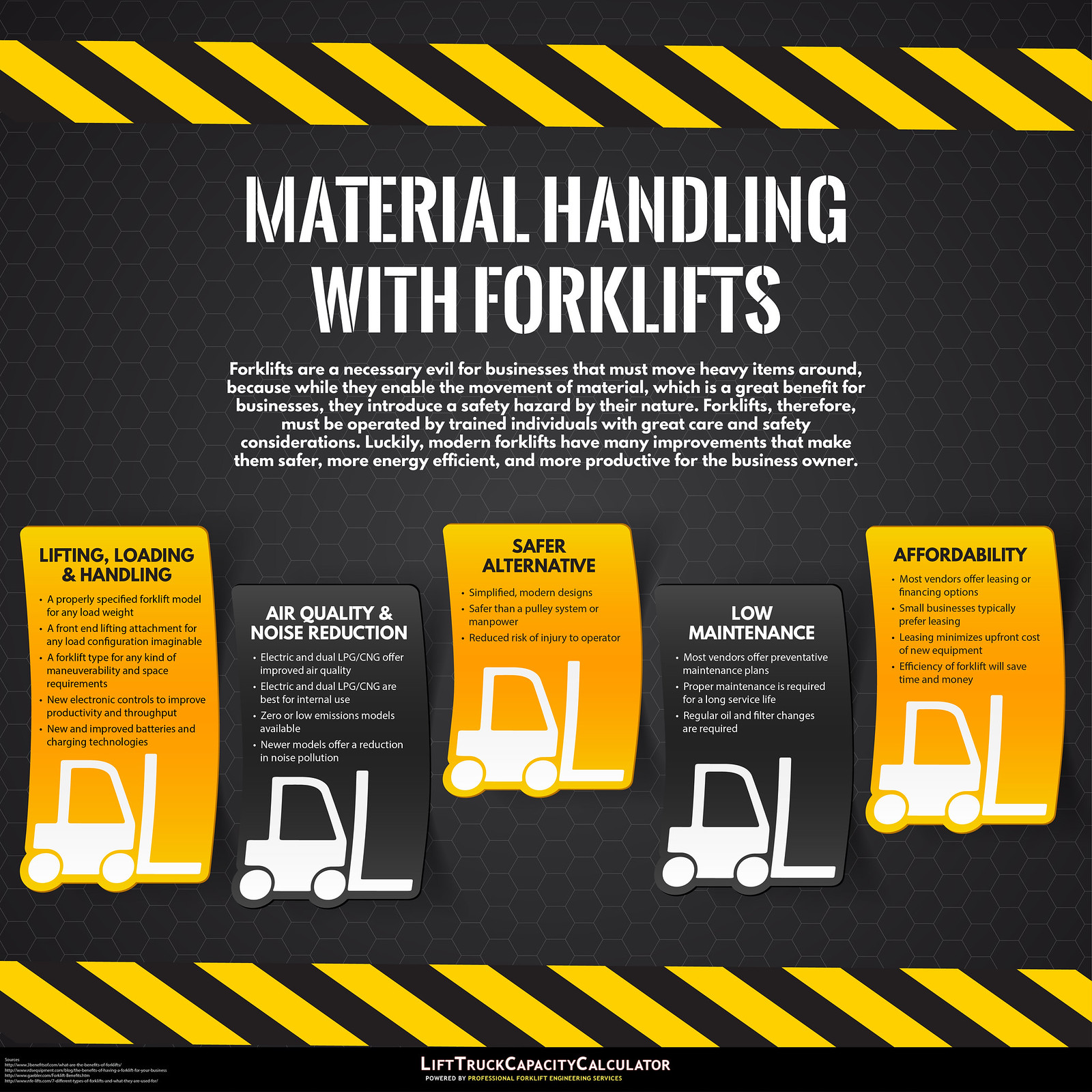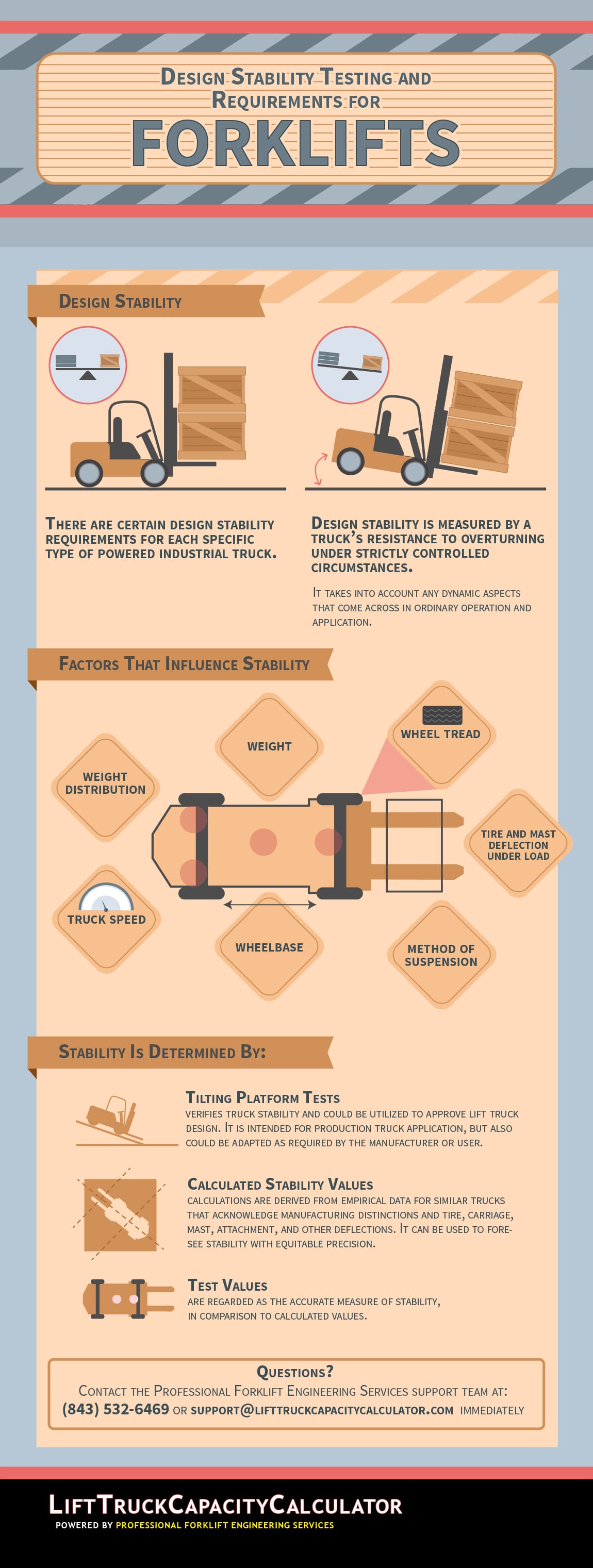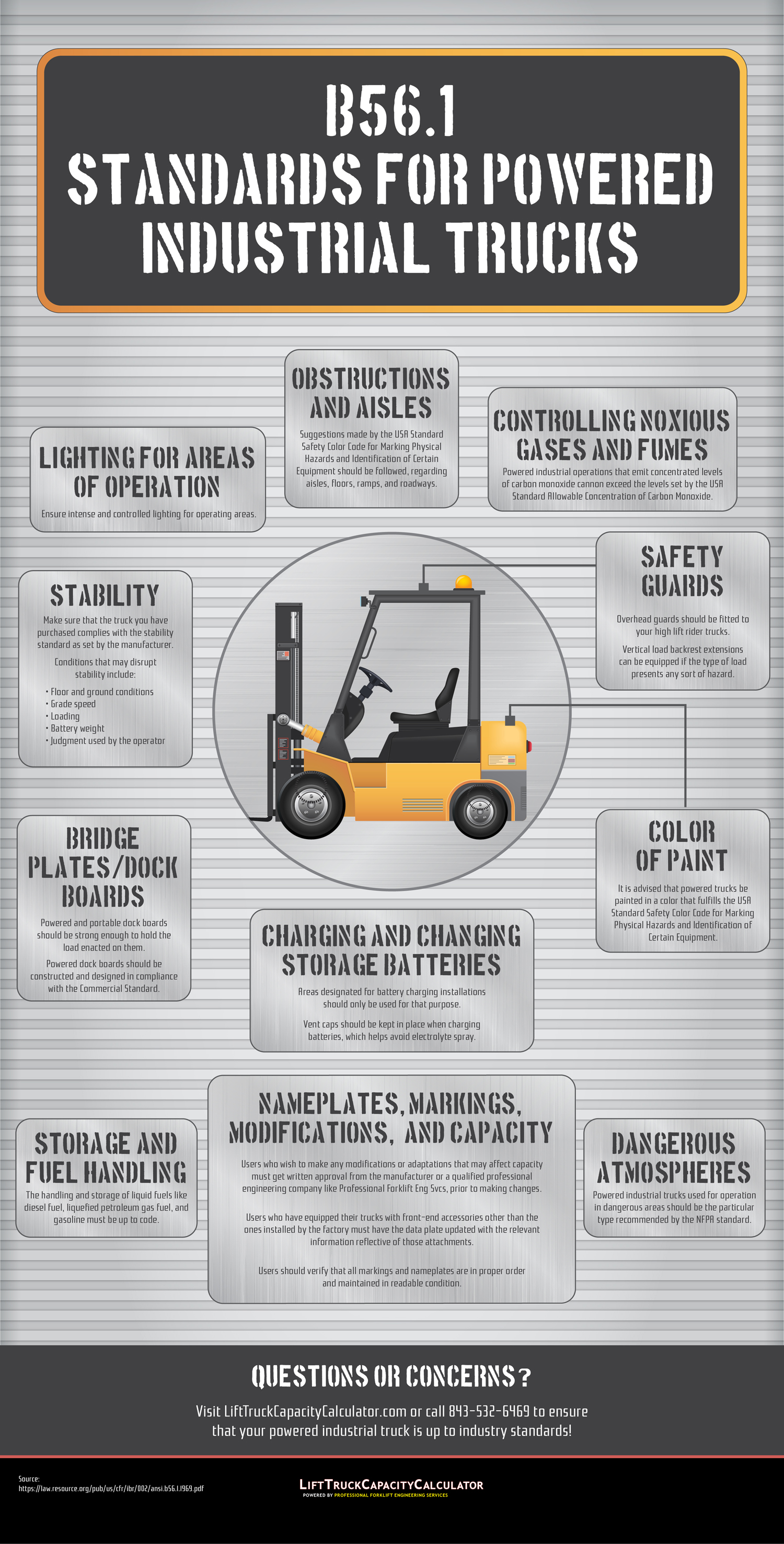Part of your job as a warehouse manager is to ensure that all of your equipment and machinery is in working order so that you can improve safety conditions for your employees and prevent accidents from happening. OSHA requires that daily pre-shift inspections of your powered industrial trucks, including forklifts, are completed to help achieve these goals. Before operating a forklift in your warehouse you want to perform a series of checks to make sure it is in working order.
With the engine off, check the condition and pressure of the tires. It is also important to inspect oil levels and see if the engine is leaking at all. The condition of the battery should also be noted so that it can be replaced if needed. Once your visual check is complete, ensure that all safety information and manuals can be easily accessed by the operator and that there is enough room above the forklift and in its path for it to be driven safely.
When you turn the engine on, the first thing you should do is listen for any unusual noises so that they can be immediately addressed. Check the brakes, steering, and gauges as well before driving the forklift. Other items that should get your attention include the forks, chain anchor pins, and hoses. If any of these appear to be worn or lose, immediate action should be taken. This will help you reduce risks to your forklift operator and help your team get their job done safely and efficiently.
The forklift operator should also check to make sure the forklift has a legible, accurate data plate that reflects the current configuration of the forklift, including any attachments being used. If the plate is missing or inaccurate, contact Professional Forklift Engineering Services, LLC at (843) 532-6469 or email at support@LiftTruckCapacityCalculator.com to get the data plate updated and the forklift re-certified.

Moving materials and items around a business, warehouse, or job site is necessary for work to be done in many businesses. This means that companies rely on forklifts to move materials, but since safety is always concern and a priority for businesses, they must practice safety to minimize risk to employees and materials. Over time forklifts have become progressively more advanced and safer for operators, but lifting, lowering and moving heavy material with forklifts is precarious by nature, and thus requires skill, care, training and knowledge to be executed safely and efficiently.
First and foremost, the operator should always be aware of the load weight limits specified on the forklift data plate or data label for the particular forklift. Different types of lift trucks have different parameters for maneuverability, operation and safety, and the operator should aware, trained and comfortable with the operation the particular forklift machine. New forklift designs simplify the learning process for operators and deliver greater benefits for companies. For growing businesses, many different machine acquisition options are available to fit the business owners needs. Forklift acquisition should always be done through local dealers and sellers who can review the onsite requirements of the business owner, and provide the necessary local service and support required to keep the forklifts in good operating condition.

As you grow your business, your need for material handling equipment will also grow. This may include forklifts and/or telehandlers as well as the types of attachments used on them to handle the material.
The forklift operator will learn how to read a forklift data plate or load chart which gives the operator information about the amount of load that can be safely lifted and to what heights and reaches. The operator will also learn to read the data plate and determine if the plate accurately represents the current configuration of the machine with the present attachments installed. If the data plate does not reflect the current attachments installed, the operator or company management may contact Professional Forklift Engineering Services, LLC at support@LiftTruckCapacityCalculator.com or 843-532-6469 to have the forklift data plate or load chart updated and the machine certified to the new safe lifting capacity.

When selecting a forklift for your business, it is important to take into account several different factors. There is no “one-size-fits-all” type of solution, even within the same industry or market segment.
Rather, each forklift should be customized to fit your specific needs and requirements. You want to evaluate and consider each of the following factors:
- The environment where the forklift will be used. Do you plan on using it indoors or outdoors or both?
- The type of facility where the forklift will be operated. Will you use it in a warehouse, in a shipping dock, or in some other type of commercial facility?
- The aisle width and door overhead clearance. The lift truck must be able to navigate and turn in the aisles and pass under any doors or overhead obstructions.
- The surfaces upon which the lift truck will operate. Will the machine be operated on smooth level polished concrete, irregular or smooth paved surfaces, gravel or rough terrain?
- The number of hours per day or week the machine will be used.
- The type of fuel used by the forklift. There are electric, gas, and diesel models to choose from and the fuel type should match the environment where it will be used.
- The maximum lifting height you require. You want to make sure the forklift can safely reach the heights you require.
- The maximum load capacity of items the forklift will be hauling. You want to choose a forklift that exceeds this amount to allow for load discrepancies from normal wear and tear.
- The type and dimensions of the loads. Some loads may require longer forks, fork extensions or a special lifting attachment.
- New or used machine? You can find both new and used models for sale but be sure to check the accuracy of the manufacturers data plate on used machines which may need to be updated per OSHA requirements prior to use.
For additional information on selecting the right forklift for any operation, we invite you to continue reviewing the following infographic. Remember to check out the tools, resources, and services available at Lift Truck Capacity Calculator to help with your research and contact professional Forklift Engineering Services, LLC with questions.

The maximum weight data placard on forklifts should never be regarded as the maximum amount able to be lifted. There are several factors that affect the lifting capacity, which is often reduced for various reasons. It is important to remember the lifting capacity is based upon the load center.
Did you know you lose the weight-lifting capacity for every one inch beyond the actual load center? It is your responsibility to calculate the load center for any type of attachment used with the truck, including the original one. In addition, each time you switch attachments, it is essential to recalculate the load center and maximum load lift capacity of the forklift.
To learn more about the factors that affect the load center and load capacities, please feel free to continue reading the following infographic presented by Lift Truck Capacity Calculator. We can also provide assistance with determining the load center for a variety of attachments, as well as those that are worn by contacting us directly.

Driving a forklift or similar heavy lifting equipment is a responsibility not to be taken lightly—if handled improperly, these heavy mobile vehicles can cause serious damage both to the immediate environment and to human beings in their path.
To a large extent, safe operating procedures are a matter of simple common sense, but sometimes accidents happen even to experienced, mindful drivers. In a significant number of these incidents, the problem can be traced to a very simple cause: inaccurate capacity data labels.
Data labels are easy enough to ignore. Some forklift drivers rarely, if ever, glance at them, preferring instead to trust gut feelings developed through long experience. This is a mistake, however. It’s important to refer to these labels to ensure the maximal operating safety of lifting equipment—but this information is useless if it is out of date or just plain wrong.
Inaccurate data labels can cause multiple problems for you; let’s explore the issue further in the infographic posted below.

If your company uses a forklift, you know how important this piece of equipment is to your business and how versatile it can be with the use of special forklift attachments. These special attachments are used to transform from simple lifting forks, into a multi-purpose machine designated for a very particular task.
The different types of special forklift attachments are virtually unlimited but typical attachments include side shifters, fork positioners, rotators, paper roll clamps, box clamps, bale clamps, appliance clamps, concrete block clamps, push-pulls (also called slip-sheet attachments), load extenders and stabilizers, hay clamps, bale spears, carriages, skips or waste bins, scoops, buckets, booms, crane jibs, fork mounted hooks, forks, fork extensions, bulk bag handlers, snow ploughs, yard scrapers, fork mounted drum handlers and drum rotators, work platforms and cages just to name a few. Special custom made and in-house fabricated attachments are also often used.
If you need to use special forklift attachments, you will also need to certify and label the forklift with an updated data plate to reflect the new forklift configuration and the new lifting capacity. Updating the data plate when you change front end attachments is an OSHA regulation that falls under OSHA regulation CFR 29 1910.178 referencing “powered industrial truck addition/modification approval and marking requirements”. Professional Forklift Engineering Services has qualified professional engineers that can help you get your forklifts OSHA compliant in this regard.
Lift Truck Capacity Calculator’s new fork mounted ram polls address the problem presented by heavy rolls of Bentonite geosynthetic liners or geosynthetic clay liners, commonly referred to as GCLs. GCLs are essential components of modern landfills, helping to contain their contents and prevent groundwater seepage.
GCL rolls are less heavy than traditional clay liners but are still very heavy. Safely handling these rolls poses a challenge for contractors working in the rough terrain typically associated with landfills. Lift Truck Capacity Calculator’s new fork mounted ram roll is specially designed to handle GCLs. The new product can safely lift GCLs up to 3,200 lbs., 16 feet wide, and three feet in diameter. Careful consideration must be exercised in designing an attachment for this application and Pro Forklift Eng Svcs has a certifiable solution available. To learn more about
Lift Truck Capacity Calculator’s innovative new fork mounted ram roll; take a look at this easy-to-understand infographic.
Stability when driving a forklift is essential so that your operators do not tip when moving a load from one place to another. There are certain design stability requirements set by the industry and manufacturers that are in place for each specific type of powered industrial truck. The term ‘design stability’ refers to the measurement of a truck’s resistance to overturning under controlled circumstances. Here are a few factors that can influence stability:
- Weight Distribution
- Truck Speed
- Wheelbase
- Suspension Method
- Wheel Tread
Taking these factors and more into account, forklifts and other industrial trucks are tested and inspected to determine stability. A tilting platform test verifies stability and can also be used to enhance forklift design to better meet the needs of operators and warehouses. Various test values are also calculated to forecast prevision and stability, followed by tests to confirm that weight distribution and other factors are adequately maintained.

Ensuring that you follow all safety standards and regulations in your warehouse is essential in order to maintain compliance and reduce the risk of injury to your employees. In addition to organizing storage spaces and improving workplace efficiency, understanding the standards set for powered trucks and forklifts will promote safety and increase accountability for your business. These govern everything from workplace lighting, to the storage, to the color of paint on the vehicle. Here are just a few to become familiar with:
- The USA Standard Safety Color Code for Marking Physical Hazards and Identification of Certain Equipment should be followed in relation to obstructions and aisles.
- Areas designated for battery charging and installations should only be used for that purpose.
- Ensure that the storage and handling of fuel, such as diesel and gasoline, are up to code.
Be sure that your management team and employees are aware of the various safety standards in place for the storage and operation of powered industrial trucks in order to avoid potential injury and loss for your organization.



